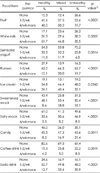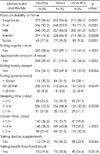Abstract
Purpose
Along with the adaptation of a Western dietary pattern and low physical activity, pediatric obesity is increasing in Korea, especially for boys. The aim of this study was to identify dietary behavior patterns and examine the snack consumption, dietary habit, and pediatric obesity by pattern groups.
Methods
Boys aged 15~19 years were recruited from one high school in Seoul. A questionnaire including dietary behaviors and lifestyle factors was administered and height and weight were measured. A total of 932 boys participated except boys who had missing or incomplete response (n = 30). Three dietary behavior patterns were identified by cluster analysis; 'Healthy pattern', 'Mixed pattern' and 'Unhealthy pattern'.
Results
Snack consumption differed according to dietary behavior patterns group. The healthy and mixed patterns showed higher frequencies of white milk and fruit consumption while the unhealthy pattern as well as the mixed patterns showed higher frequencies of sweetened snack and ice cream consumption. Food availability at home of each food differed according to pattern groups but showed a similar trend with food consumption. Regarding dietary habits, the mixed pattern showed higher proportion of taking dietary supplement and eating dessert while the unhealthy pattern showed lower proportion of eating regular meals and appropriate amount of meals. When the healthy pattern was set as a reference group, the odds ratio of pediatric obesity was 1.11 (CI 0.65-1.87) in the mixed pattern group and 1.88 (CI 1.14-3.10) in the unhealthy pattern group.
Figures and Tables
Table 1
Three dietary behavior patterns based on 18 items of dietary guidelines for Korean adolescents by cluster analysis

1) A group of individuals were characterized by high compliance with almost components of the dietary guidelines. 2) A group of individuals were characterized by high compliance with some components but low compliance with the others of the dietary guidelines. 3) A group of individuals were characterized by low compliance with almost components of the dietary guidelines. 4) The number and percentage of subjects who answered 'Yes' on each item.
References
1. Noh E, Eun S, Joo Y. The policy support plans of obesity prevention and management for childhood and adolescent. Seoul: The Seoul Institute;2012.
2. Oh K, Jang MJ, Lee NY, Moon JS, Lee CG, Yoo MH, Kim YT. Prevalence and trends in obesity among Korean children and adolescents in 1997 and 2005. Korean J Pediatr. 2008; 51(9):950–955.

3. Ogden CL, Carroll MD, Kit BK, Flegal KM. Prevalence of obesity in the United States, 2009-2010. NCHS Data Brief. 2012; (82):1–8.
4. Matsushita Y, Yoshiike N, Kaneda F, Yoshita K, Takimoto H. Trends in childhood obesity in Japan over the last 25 years from the national nutrition survey. Obes Res. 2004; 12(2):205–214.

5. Bjørge T, Engeland A, Tverdal A, Smith GD. Body mass index in adolescence in relation to cause-specific mortality: a follow-up of 230,000 Norwegian adolescents. Am J Epidemiol. 2008; 168(1):30–37.
6. Sinha R, Fisch G, Teague B, Tamborlane WV, Banyas B, Allen K, Savoye M, Rieger V, Taksali S, Barbetta G, Sherwin RS, Caprio S. Prevalence of impaired glucose tolerance among children and adolescents with marked obesity. N Engl J Med. 2002; 346(11):802–810.

7. Krebs NF, Jacobson MS. American Academy of Pediatrics Committee on Nutrition. Prevention of pediatric overweight and obesity. Pediatrics. 2003; 112(2):424–430.
8. Nielsen SJ, Siega-Riz AM, Popkin BM. Trends in food locations and sources among adolescents and young adults. Prev Med. 2002; 35(2):107–113.

9. Paeratakul S, Ferdinand DP, Champagne CM, Ryan DH, Bray GA. Fast-food consumption among US adults and children: dietary and nutrient intake profile. J Am Diet Assoc. 2003; 103(10):1332–1338.

10. St-Onge MP, Keller KL, Heymsfield SB. Changes in childhood food consumption patterns: a cause for concern in light of increasing body weights. Am J Clin Nutr. 2003; 78(6):1068–1073.

11. Rampersaud GC, Pereira MA, Girard BL, Adams J, Metzl JD. Breakfast habits, nutritional status, body weight, and academic performance in children and adolescents. J Am Diet Assoc. 2005; 105(5):743–760.

12. Niemeier HM, Raynor HA, Lloyd-Richardson EE, Rogers ML, Wing RR. Fast food consumption and breakfast skipping: predictors of weight gain from adolescence to adulthood in a nationally representative sample. J Adolesc Health. 2006; 39(6):842–849.

13. Ministry of Education. Ministry of Health and Welfare. Korea Centers for Disease Control and Prevention. Korea youth risk behavior web-based survey from 2014 [Internet]. Cheongju: Korea Centers for Disease Control and Prevention;2014. 12. 05. cited 2014 Dec 12. Available from: http://www.yhs.cdc.go.kr/.
14. Nemet D, Barkan S, Epstein Y, Friedland O, Kowen G, Eliakim A. Short- and long-term beneficial effects of a combined dietary-behavioral-physical activity intervention for the treatment of childhood obesity. Pediatrics. 2005; 115(4):e443–e449.

15. Neumark-Sztainer D, Rock CL, Thornquist MD, Cheskin LJ, Neuhouser ML, Barnett MJ. Weight-control behaviors among adults and adolescents: associations with dietary intake. Prev Med. 2000; 30(5):381–391.

16. Leech RM, McNaughton SA, Timperio A. The clustering of diet, physical activity and sedentary behavior in children and adolescents: a review. Int J Behav Nutr Phys Act. 2014; 11:4.

17. Sanchez A, Norman GJ, Sallis JF, Calfas KJ, Cella J, Patrick K. Patterns and correlates of physical activity and nutrition behaviors in adolescents. Am J Prev Med. 2007; 32(2):124–130.

18. Hardy LL, Grunseit A, Khambalia A, Bell C, Wolfenden L, Milat AJ. Co-occurrence of obesogenic risk factors among adolescents. J Adolesc Health. 2012; 51(3):265–271.

19. Jee YJ, Kim YH. Factors influencing obesity among adolescent: analysis of 2011 Korean Youth Risk Behavior Survey. Korean J Obes. 2013; 22(1):39–49.

20. Ministry of Health and Welfare (KR). The 2003 dietary guidelines for Koreans. Dietary action guides for adolescents. Seoul: Ministry of Health and Welfare;2003.
21. Moon JS, Lee SY, Nam CM, Choi JM, Choe BK, Seo JW, Oh K, Jang MJ, Hwang SS, Yoo MH, Kim YT, Lee CG. 2007 Korean National Growth Charts: review of developmental process and an outlook. Korean J Pediatr. 2008; 51(1):1–25.

22. Story M, Neumark-Sztainer D, French S. Individual and environmental influences on adolescent eating behaviors. J Am Diet Assoc. 2002; 102:3 Suppl. S40–S51.

23. Steinmetz KA, Potter JD. Vegetables, fruit, and cancer prevention: a review. J Am Diet Assoc. 1996; 96(10):1027–1039.




 PDF
PDF ePub
ePub Citation
Citation Print
Print





 XML Download
XML Download